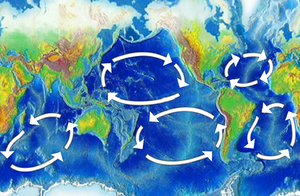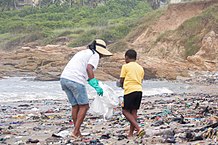Ocean
| Earth's ocean | |
|---|---|
 Pacific Ocean side, Apollo 11, July 1969 | |
| Basin countries | List of countries by length of coastline |
| Surface area | 361,000,000 km2 (139,382,879 sq mi) (71% Earth's surface area)[1] |
| Average depth | 3.688 km (2 mi)[2] |
| Max. depth | 11.034 km (6.856 mi) (Challenger Deep)[3] |
| Water volume | 1,370,000,000 km3 (328,680,479 cu mi)[1] (97.5% of Earth's water) |
| Shore length1 | Low interval calculation: 356,000 km (221,208 mi)[4] High interval calculation: 1,634,701 km (1,015,756 mi)[5][vague] |
| Max. temperature | |
| Min. temperature | |
| Sections/sub-basins | Main divisions (volume %):
List of oceanic trenches |
| 1 Shore length is not a well-defined measure. | |
The ocean is the body of salt water that covers ~70.8% of the Earth.[8] In English, the term ocean also refers to any of the large bodies of water into which the world ocean is conventionally divided.[9] Distinct names are used to identify five different areas of the ocean: Pacific, Atlantic, Indian, Antarctic/Southern, and Arctic.[10][11] The ocean contains 97% of Earth's water[8] and is the primary component of the Earth's hydrosphere, thus the ocean is essential to life on Earth. The ocean influences climate and weather patterns, the carbon cycle, and the water cycle by acting as a huge heat reservoir.
Ocean water contains a high concentration of dissolved gases, including oxygen, carbon dioxide and nitrogen. This gas exchange occurs at the ocean's surface and solubility depends on the temperature and salinity of the water.[16] Carbon dioxide concentration in the atmosphere rises due to fossil fuel combustion, which causes higher levels in ocean water, resulting in ocean acidification.[17] The ocean provides crucial environmental services to humankind, such as climate regulation. It also provides a means of trade and transport as well as access to food and other resources. It is known to be the habitat of over 230,000 species, but may hold considerably more – perhaps over two million species.[18] However, the ocean faces numerous human-caused environmental threats, such as marine pollution, overfishing, and effects of climate change on oceans such as ocean warming, ocean acidification and sea level rise. The continental shelf and coastal waters that are most affected by human activity are particularly vulnerable.
Terminology
Ocean and sea
The terms "the ocean" or "the sea" used without specification refer to the interconnected body of salt water covering the majority of the Earth's surface.[10][11] It includes the Atlantic, Pacific, Indian, Antarctic/Southern and Arctic Oceans.[19] As a general term, "the ocean" and "the sea" are often interchangeable, although speakers of British English refer to "the sea" in all cases,[20][dubious ] even when the body of water is one of the oceans.
Strictly speaking, a "sea" is a body of water (generally a division of the world ocean) partly or fully enclosed by land.
World ocean
The contemporary concept of the World Ocean was coined in the early 20th century by the Russian oceanographer Yuly Shokalsky to refer to the continuous ocean that covers and encircles most of the Earth.[23][24] The global, interconnected body of salt water is sometimes referred to as the World Ocean, global ocean or the great ocean.[25][26][27] The concept of a continuous body of water with relatively unrestricted exchange between its components is critical in oceanography.[28]
Etymology
The word ocean comes from the figure in
The concept of Ōkeanós has an
Natural history
Origin of water
Scientists believe that a sizable quantity of water would have been in the material that formed Earth.[31] Water molecules would have escaped Earth's gravity more easily when it was less massive during its formation. This is called atmospheric escape.
During
, according to current theories. The gases and the atmosphere are thought to have accumulated over millions of years. After Earth's surface had significantly cooled, the water vapor over time would have condensed, forming Earth's first oceans.[32] The early oceans might have been significantly hotter than today and appeared green due to high iron content.[33]Geological evidence helps constrain the time frame for liquid water existing on Earth. A sample of pillow basalt (a type of rock formed during an underwater eruption) was recovered from the Isua Greenstone Belt and provides evidence that water existed on Earth 3.8 billion years ago.[34] In the Nuvvuagittuq Greenstone Belt, Quebec, Canada, rocks dated at 3.8 billion years old by one study[35] and 4.28 billion years old by another[36] show evidence of the presence of water at these ages.[34] If oceans existed earlier than this, any geological evidence either has yet to be discovered, or has since been destroyed by geological processes like crustal recycling. However, in August 2020, researchers reported that sufficient water to fill the oceans may have always been on the Earth since the beginning of the planet's formation.[37][38][39] In this model, atmospheric greenhouse gases kept the oceans from freezing when the newly forming Sun had only 70% of its current luminosity.[40]
Ocean formation
The origin of Earth's oceans is unknown. Oceans are thought to have formed in the Hadean eon and may have been the cause for the emergence of life.
Plate tectonics, post-glacial rebound, and sea level rise continually change the coastline and structure of the world ocean. A global ocean has existed in one form or another on Earth for eons.
Since its formation the ocean has taken many conditions and shapes with many past ocean divisions and potentially at times covering the whole globe.[41]
During colder climatic periods, more ice caps and glaciers form, and enough of the global water supply accumulates as ice to lessen the amounts in other parts of the water cycle. The reverse is true during warm periods. During the last ice age, glaciers covered almost one-third of Earth's land mass with the result being that the oceans were about 122 m (400 ft) lower than today. During the last global "warm spell," about 125,000 years ago, the seas were about 5.5 m (18 ft) higher than they are now. About three million years ago the oceans could have been up to 50 m (165 ft) higher.[42]
Geography
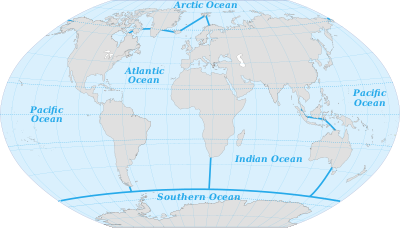
The entire ocean, containing 97% of Earth's water, spans 70.8% of
Oceanic divisions

There are different customs to subdivide the ocean and are adjourned by smaller bodies of water such as,
.The ocean is customarily divided into five principal oceans – listed below in descending order of area and volume:
| # | Ocean | Location | Area (km2) |
Volume (km3) |
Avg. depth (m) |
Coastline (km)[48] |
|---|---|---|---|---|---|---|
| 1 | Pacific Ocean | Between Asia and Australasia and the Americas[49] | 168,723,000 (46.6%) |
669,880,000 (50.1%) |
3,970 | 135,663 (35.9%) |
| 2 | Atlantic Ocean | Between the Americas and Europe and Africa[50] | 85,133,000 (23.5%) |
310,410,900 (23.3%) |
3,646 | 111,866 (29.6%) |
| 3 | Indian Ocean | Between southern Asia, Africa and Australia[51] | 70,560,000 (19.5%) |
264,000,000 (19.8%) |
3,741 | 66,526 (17.6%) |
| 4 | Antarctic/Southern Ocean | Between Antarctica and the Pacific, Atlantic and Indian oceans Sometimes considered an extension of those three oceans.[52][53] |
21,960,000 (6.1%) |
71,800,000 (5.4%) |
3,270 | 17,968 (4.8%) |
| 5 | Arctic Ocean | Between northern | 15,558,000 (4.3%) |
18,750,000 (1.4%) |
1,205 | 45,389 (12.0%) |
| Total | 361,900,000 (100%) |
1.335×109 (100%) |
3,688 | 377,412 (100%) | ||
Sources: Encyclopedia of Earth,[49][50][51][52][56] International Hydrographic Organization,[53] Regional Oceanography: an Introduction (Tomczak, 2005),[54] Encyclopædia Britannica,[55] and the International Telecommunication Union.[48]
Ocean basins
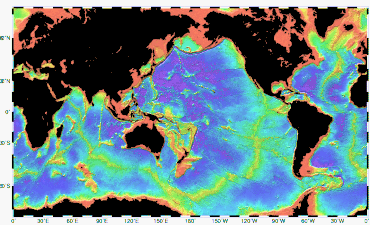
The ocean fills Earth's oceanic basins. Earth's oceanic basins cover different geologic provinces of Earth's oceanic crust as well as continental crust. As such it covers mainly Earth's structural basins, but also continental shelfs.
In mid-ocean,
Every ocean basin has a mid-ocean ridge, which creates a long mountain range beneath the ocean. Together they form the global mid-oceanic ridge system that features the longest mountain range in the world. The longest continuous mountain range is 65,000 km (40,000 mi). This underwater mountain range is several times longer than the longest continental mountain range – the Andes.[59]
Oceanographers state that less than 20% of the oceans have been mapped.[60][vague]
Interaction with the coast
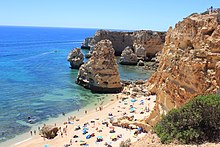
The zone where land meets sea is known as the
Normally, waves roll towards the shore at the rate of six to eight per minute and these are known as constructive waves as they tend to move material up the beach and have little erosive effect. Storm waves arrive on shore in rapid succession and are known as destructive waves as the swash moves beach material seawards. Under their influence, the sand and shingle on the beach is ground together and abraded. Around high tide, the power of a storm wave impacting on the foot of a cliff has a shattering effect as air in cracks and crevices is compressed and then expands rapidly with release of pressure. At the same time, sand and pebbles have an erosive effect as they are thrown against the rocks. This tends to undercut the cliff, and normal weathering processes such as the action of frost follows, causing further destruction. Gradually, a wave-cut platform develops at the foot of the cliff and this has a protective effect, reducing further wave-erosion.[61]
Material worn from the margins of the land eventually ends up in the sea. Here it is subject to attrition as currents flowing parallel to the coast scour out channels and transport sand and pebbles away from their place of origin. Sediment carried to the sea by rivers settles on the seabed causing deltas to form in estuaries. All these materials move back and forth under the influence of waves, tides and currents.[61] Dredging removes material and deepens channels but may have unexpected effects elsewhere on the coastline. Governments make efforts to prevent flooding of the land by the building of breakwaters, seawalls, dykes and levees and other sea defences. For instance, the Thames Barrier is designed to protect London from a storm surge,[63] while the failure of the dykes and levees around New Orleans during Hurricane Katrina created a humanitarian crisis in the United States.
Physical properties
Color
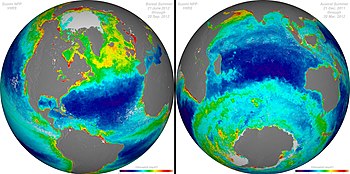
Most of the ocean is blue in color, but in some places the ocean is blue-green, green, or even yellow to brown.[64] Blue ocean color is a result of several factors. First, water preferentially absorbs red light, which means that blue light remains and is reflected back out of the water. Red light is most easily absorbed and thus does not reach great depths, usually to less than 50 meters (164 ft). Blue light, in comparison, can penetrate up to 200 meters (656 ft).[65] Second, water molecules and very tiny particles in ocean water preferentially scatter blue light more than light of other colors. Blue light scattering by water and tiny particles happens even in the very clearest ocean water,[66] and is similar to blue light scattering in the sky.
The main substances that affect the color of the ocean includeWater cycle, weather and rainfall
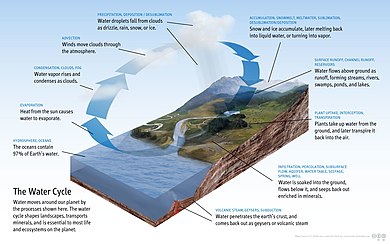
Ocean water represents the largest body of water within the global water cycle (oceans contain 97% of Earth's water). Evaporation from the ocean moves water into the atmosphere to later rain back down onto land and the ocean.[68] Oceans have a significant effect on the biosphere. The ocean as a whole is thought to cover approximately 90% of the Earth's biosphere.[60] Oceanic evaporation, as a phase of the water cycle, is the source of most rainfall (about 90%),[68] causing a global cloud cover of 67% and a consistent oceanic cloud cover of 72%.[69] Ocean temperatures affect climate and wind patterns that affect life on land. One of the most dramatic forms of weather occurs over the oceans: tropical cyclones (also called "typhoons" and "hurricanes" depending upon where the system forms).
As the world's ocean is the principal component of Earth's hydrosphere, it is integral to life on Earth, forms part of the carbon cycle and water cycle, and – as a huge heat reservoir – influences climate and weather patterns.
Waves and swell
The motions of the ocean surface, known as undulations or
Wind blowing over the surface of a body of water forms
The top of a wave is known as the crest, the lowest point between waves is the trough and the distance between the crests is the wavelength. The wave is pushed across the surface of the ocean by the wind, but this represents a transfer of energy and not horizontal movement of water. As waves approach land and
Sea level and surface
The
The ocean surface is a crucial interface for oceanic and atmospheric processes. Allowing interchange of particles, enriching the air and water, as well as grounds by some particles becoming sediments. This interchange has fertilized life in the ocean, on land and air. All these processes and components together make up ocean surface ecosystems.
Tides

Tides are the regular rise and fall in water level experienced by oceans, primarily driven by
The primary effect of lunar tidal forces is to bulge Earth matter towards the near and far sides of the Earth, relative to the moon. The "perpendicular" sides, from which the Moon appears in line with the local horizon, experience "tidal troughs". Since it takes nearly 25 hours for the Earth to rotate under the Moon (accounting for the Moon's 28 day orbit around Earth), tides thus cycle over a course of 12.5 hours. However, the rocky continents pose obstacles for the tidal bulges, so the timing of tidal maxima may not actually align with the Moon in most localities on Earth, as the oceans are forced to "dodge" the continents. Timing and magnitude of tides vary widely across the Earth as a result of the continents. Thus, knowing the Moon's position does not allow a local to predict tide timings, instead requiring precomputed tide tables which account for the continents and the Sun, among others.
During each tidal cycle, at any given place the tidal waters rise to maximum height, high tide, before ebbing away again to the minimum level, low tide. As the water recedes, it gradually reveals the
In the open ocean tidal ranges are less than 1 meter, but in coastal areas these tidal ranges increase to more than 10 meters in some areas.[84] Some of the largest tidal ranges in the world occur in the Bay of Fundy and Ungava Bay in Canada, reaching up to 16 meters.[85] Other locations with record high tidal ranges include the Bristol Channel between England and Wales, Cook Inlet in Alaska, and the Río Gallegos in Argentina.[86]
Tides are not to be confused with storm surges, which can occur when high winds pile water up against the coast in a shallow area and this, coupled with a low pressure system, can raise the surface of the ocean dramatically above a typical high tide.
Depth
The average depth of the oceans is about 4 km. More precisely the average depth is 3,688 meters (12,100 ft).[72] Nearly half of the world's marine waters are over 3,000 meters (9,800 ft) deep.[27] "Deep ocean," which is anything below 200 meters (660 ft), covers about 66% of Earth's surface.[87] This figure does not include seas not connected to the World Ocean, such as the Caspian Sea.
The deepest region of the ocean is at the
Oceanic zones

Oceanographers classify the ocean into vertical and horizontal zones based on physical and biological conditions. The pelagic zone consists of the water column of the open ocean, and can be divided into further regions categorized by light abundance and by depth.
Grouped by light penetration
The ocean zones can be grouped by light penetration into (from top to bottom): the photic zone, the mesopelagic zone and the aphotic deep ocean zone:
- The biodiverse. Photosynthesis by plants and microscopic algae (free floating phytoplankton) allows the creation of organic matter from chemical precursors including water and carbon dioxide. This organic matter can then be consumed by other creatures. Much of the organic matter created in the photic zone is consumed there but some sinks into deeper waters. The pelagic part of the photic zone is known as the epipelagic.[89] The actual optics of light reflecting and penetrating at the ocean surface are complex.[12]: 34–39
- Below the photic zone is the mesopelagic or twilight zone where there is a very small amount of light. The basic concept is that with that little light photosynthesis is unlikely to achieve any net growth over respiration.[12]: 116–124
- Below that is the aphotic deep ocean to which no surface sunlight at all penetrates. Life that exists deeper than the photic zone must either rely on material sinking from above (see Hydrothermal vents are a source of energy in what is known as the aphotic zone (depths exceeding 200 m).[89]
Grouped by depth and temperature
The pelagic part of the aphotic zone can be further divided into vertical regions according to depth and temperature:[89]
- The bathypelagic lying between 10 and 4 °C (50 and 39 °F), typically between 700–1,000 meters (2,300–3,300 ft) and 2,000–4,000 meters (6,600–13,100 ft). Lying along the top of the abyssal plain is the abyssopelagic, whose lower boundary lies at about 6,000 meters (20,000 ft). The last and deepest zone is the hadalpelagic which includes the oceanic trenchand lies between 6,000–11,000 meters (20,000–36,000 ft).
- The hadalzone corresponds to the hadalpelagic zone, which is found in oceanic trenches.
Distinct boundaries between ocean surface waters and deep waters can be drawn based on the properties of the water. These boundaries are called thermoclines (temperature), haloclines (salinity), chemoclines (chemistry), and pycnoclines (density). If a zone undergoes dramatic changes in temperature with depth, it contains a thermocline, a distinct boundary between warmer surface water and colder deep water. In tropical regions, the thermocline is typically deeper compared to higher latitudes. Unlike polar waters, where solar energy input is limited, temperature stratification is less pronounced, and a distinct thermocline is often absent. This is due to the fact that surface waters in polar latitudes are nearly as cold as deeper waters. Below the thermocline, water everywhere in the ocean is very cold, ranging from −1 °C to 3 °C. Because this deep and cold layer contains the bulk of ocean water, the average temperature of the world ocean is 3.9 °C.[90] If a zone undergoes dramatic changes in salinity with depth, it contains a halocline. If a zone undergoes a strong, vertical chemistry gradient with depth, it contains a chemocline. Temperature and salinity control ocean water density. Colder and saltier water is denser, and this density plays a crucial role in regulating the global water circulation within the ocean.[89] The halocline often coincides with the thermocline, and the combination produces a pronounced pycnocline, a boundary between less dense surface water and dense deep water.
Grouped by distance from land
The pelagic zone can be further subdivided into two sub regions based on distance from land: the
The
Volumes
The combined volume of water in all the oceans is roughly 1.335 billion cubic kilometers (1.335
It has been estimated that there are 1.386 billion cubic kilometres (333 million cubic miles) of water on Earth.
Temperature
Ocean temperatures depends on the amount of solar radiation falling on its surface. In the tropics, with the Sun nearly overhead, the temperature of the surface layers can rise to over 30 °C (86 °F) while near the poles the temperature in equilibrium with the sea ice is about −2 °C (28 °F). There is a continuous circulation of water in the oceans. Warm surface currents cool as they move away from the tropics, and the water becomes denser and sinks. The cold water moves back towards the equator as a deep sea current, driven by changes in the temperature and density of the water, before eventually welling up again towards the surface. Deep ocean water has a temperature between −2 °C (28 °F) and 5 °C (41 °F) in all parts of the globe.[14]
The temperature gradient over the water depth is related to the way the surface water mixes with deeper water or does not mix (a lack of mixing is called ocean stratification). This depends on the temperature: in the tropics the warm surface layer of about 100 m is quite stable and does not mix much with deeper water, while near the poles winter cooling and storms makes the surface layer denser and it mixes to great depth and then stratifies again in summer. The photic depth is typically about 100 m (but varies) and is related to this heated surface layer.[98]
Temperature and salinity by region
The temperature and salinity of ocean waters vary significantly across different regions. This is due to differences in the local water balance (precipitation vs. evaporation) and the "sea to air" temperature gradients. These characteristics can vary widely from one ocean region to another. The table below provides an illustration of the sort of values usually encountered.
| Characteristic | Polar regions | Temperate regions | Tropical regions |
|---|---|---|---|
| Precipitation vs. evaporation | Precip > Evap | Precip > Evap | Evap > Precip |
| Sea surface temperature in winter | −2 °C | 5 to 20 °C | 20 to 25 °C |
| Average salinity | 28‰ to 32‰ | 35‰ | 35‰ to 37‰ |
| Annual variation of air temperature
|
≤ 40 °C | 10 °C | < 5 °C |
| Annual variation of water temperature
|
< 5 °C | 10 °C | < 5 °C |
Sea ice
Seawater with a typical salinity of 35‰ has a freezing point of about −1.8 °C (28.8 °F).[89][107] Because sea ice is less dense than water, it floats on the ocean's surface (as does fresh water ice, which has an even lower density). Sea ice covers about 7% of the Earth's surface and about 12% of the world's oceans.[108][109][110] Sea ice usually starts to freeze at the very surface, initially as a very thin ice film. As further freezing takes place, this ice film thickens and can form ice sheets. The ice formed incorporates some sea salt, but much less than the seawater it forms from. As the ice forms with low salinity this results in saltier residual seawater. This in turn increases density and promotes vertical sinking of the water.[111]
Ocean currents and global climate
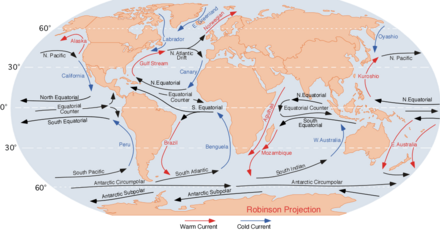
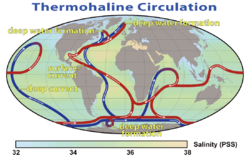
Types of ocean currents
An
Ocean currents are primarily horizontal water movements that have different origins such as tides for tidal currents, or wind and waves for surface currents.Tidal currents are in phase with the
The wind and waves create surface currents (designated as "drift currents"). These currents can decompose in one quasi-permanent current (which varies within the hourly scale) and one movement of Stokes drift under the effect of rapid waves movement (which vary on timescales of a couple of seconds). The quasi-permanent current is accelerated by the breaking of waves, and in a lesser governing effect, by the friction of the wind on the surface.[113]
This acceleration of the current takes place in the direction of waves and dominant wind. Accordingly, when the ocean depth increases, the rotation of the earth changes the direction of currents in proportion with the increase of depth, while friction lowers their speed. At a certain ocean depth, the current changes direction and is seen inverted in the opposite direction with current speed becoming null: known as the Ekman spiral. The influence of these currents is mainly experienced at the mixed layer of the ocean surface, often from 400 to 800 meters of maximum depth. These currents can considerably change and are dependent on the yearly seasons. If the mixed layer is less thick (10 to 20 meters), the quasi-permanent current at the surface can adopt quite a different direction in relation to the direction of the wind. In this case, the water column becomes virtually homogeneous above the thermocline.[113]
The wind blowing on the ocean surface will set the water in motion. The global pattern of winds (also called atmospheric circulation) creates a global pattern of ocean currents. These are driven not only by the wind but also by the effect of the circulation of the earth (coriolis force). These major ocean currents include the Gulf Stream, Kuroshio current, Agulhas current and Antarctic Circumpolar Current. The Antarctic Circumpolar Current encircles Antarctica and influences the area's climate, connecting currents in several oceans.[113]
Relationship of currents and climate
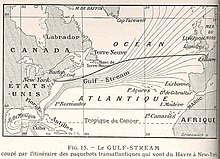
Collectively, currents move enormous amounts of water and heat around the globe influencing climate. These wind driven currents are largely confined to the top hundreds of meters of the ocean. At greater depth, the thermohaline circulation (Atlantic meridional overturning circulation (AMOC), which is part of a global thermoholine circulation, drives water motion.The AMOC is driven by the cooling of surface waters in the polar latitudes in the north and south, creating dense water which sinks to the bottom of the ocean. This cold and dense water moves slowly away from the poles which is why the waters in the deepest layers of the world ocean are so cold. This deep ocean water circulation is relatively slow and water at the bottom of the ocean can be isolated from the ocean surface and atmosphere for hundreds or even a few thousand years.[113] This circulation has important impacts on global climate and the uptake and redistribution of pollutants such as carbon dioxide by moving these contaminants from the surface into the deep ocean.
Oceans moderate the climate of locations where prevailing winds blow in from the ocean. At similar latitudes, a place on Earth with more influence from the ocean will have a more moderate climate than a place with more influence from land. For example, the cities San Francisco (37.8 N) and New York (40.7 N) have different climates because San Francisco has more influence from the ocean. San Francisco, on the west coast of North America, gets winds from the west over the Pacific Ocean, and the influence of the ocean water yields a more moderate climate with a warmer winter and a longer, cooler summer, with the warmest temperatures happening later in the year. New York, on the east coast of North America gets winds from the west over land, so New York has colder winters and hotter, earlier summers than San Francisco.
Warmer ocean currents yield warmer climates in the long term, even at high latitudes. At similar latitudes, a place influenced by warm ocean currents will have a warmer climate overall than a place influenced by cold ocean currents. French Riviera (43.5 N) and Rockland, Maine (44.1 N) have same latitude, but the French Riviera is influenced by warm waters transported by the Gulf Stream into the Mediterranean Sea and has a warmer climate overall. Maine is influenced by cold waters transported south by the Labrador Current giving it a colder climate overall.
Changes in the thermohaline circulation are thought to have significant impacts on Earth's energy budget. Because the thermohaline circulation determines the rate at which deep waters reach the surface, it may also significantly influence atmospheric carbon dioxide concentrations. Modern observations, climate simulations and paleoclimate reconstructions suggest that the Atlantic Meridional Overturning Circulation (AMOC) has weakened since the preindustrial era. The latest climate change projections in 2021 suggest that the AMOC is likely to weaken further over the 21st century.[114]: 19 Such a weakening could cause large changes to global climate, with the North Atlantic particularly vulnerable.[114]: 19
Chemical properties
Salinity

Salinity is a measure of the total amounts of dissolved salts in seawater. It was originally measured via measurement of the amount of chloride in seawater and hence termed chlorinity. It is now standard practice to gauge it by measuring electrical conductivity of the water sample. Salinity can be calculated using the chlorinity, which is a measure of the total mass of halogen ions (includes fluorine, chlorine, bromine, and iodine) in seawater. According to an international agreement, the following formula is used to determine salinity:[116]
- Salinity (in ‰) = 1.80655 × Chlorinity (in ‰)
The average ocean water chlorinity is about 19.2‰, and, thus, the average salinity is around 34.7‰.[116]
Salinity has a major influence on the density of seawater. A zone of rapid salinity increase with depth is called a halocline. As seawater's salt content increases, so does the temperature at which its maximum density occurs. Salinity affects both the freezing and boiling points of water, with the boiling point increasing with salinity. At atmospheric pressure,[117] normal seawater freezes at a temperature of about −2 °C.
Salinity is higher in Earth's oceans where there is more evaporation and lower where there is more precipitation. If precipitation exceeds evaporation, as is the case in polar and some temperate regions, salinity will be lower. Salinity will be higher if evaporation exceeds precipitation, as is sometimes the case in tropical regions. For example, evaporation is greater than precipitation in the Mediterranean Sea, which has an average salinity of 38‰, more saline than the global average of 34.7‰.[118] Thus, oceanic waters in polar regions have lower salinity content than oceanic waters in tropical regions.[116] However, when sea ice forms at high latitudes, salt is excluded from the ice as it forms, which can increase the salinity in the residual seawater in polar regions such as the Arctic Ocean.[89][119]
Due to the effects of climate change on oceans, observations of sea surface salinity between 1950 and 2019 indicate that regions of high salinity and evaporation have become more saline while regions of low salinity and more precipitation have become fresher.[120] It is very likely that the Pacific and Antarctic/Southern Oceans have freshened while the Atlantic has become more saline.[120]
Dissolved gases

Ocean water contains large quantities of dissolved gases, including
Oxygen, photosynthesis and carbon cycling
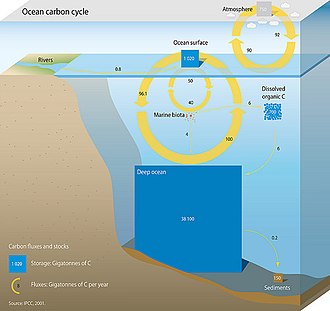
Photosynthesis in the surface ocean releases oxygen and consumes carbon dioxide. Phytoplankton, a type of microscopic free-floating algae, controls this process. After the plants have grown, oxygen is consumed and carbon dioxide released, as a result of bacterial decomposition of the organic matter created by photosynthesis in the ocean. The sinking and bacterial decomposition of some organic matter in deep ocean water, at depths where the waters are out of contact with the atmosphere, leads to a reduction in oxygen concentrations and increase in carbon dioxide, carbonate and bicarbonate.[98] This cycling of carbon dioxide in oceans is an important part of the global carbon cycle.
The oceans represent a major
As deep ocean water circulates throughout the globe, it contains gradually less oxygen and gradually more carbon dioxide with more time away from the air at the surface. This gradual decrease in oxygen concentration happens as sinking organic matter continuously gets decomposed during the time the water is out of contact with the atmosphere.[98] Most of the deep waters of the ocean still contain relatively high concentrations of oxygen sufficient for most animals to survive. However, some ocean areas have very low oxygen due to long periods of isolation of the water from the atmosphere. These oxygen deficient areas, called oxygen minimum zones or hypoxic waters, will generally be made worse by the effects of climate change on oceans.[127][128]
pH
The
There is a natural gradient of pH in the ocean which is related to the breakdown of organic matter in deep water which slowly lowers the pH with depth: The pH value of seawater is naturally as low as 7.8 in deep ocean waters as a result of degradation of organic matter there.
The definition of global mean surface pH refers to the top layer of the water in the ocean, up to around 20 or 100 m depth. In comparison, the average depth of the ocean is about 4 km. The pH value at greater depths (more than 100 m) has not yet been affected by ocean acidification in the same way. There is a large body of deeper water where the natural gradient of pH from 8.2 to about 7.8 still exists and it will take a very long time to acidify these waters, and equally as long to recover from that acidification. But as the top layer of the ocean (the photic zone) is crucial for its marine productivity, any changes to the pH value and temperature of the top layer can have many knock-on effects, for example on marine life and ocean currents (see also effects of climate change on oceans).[98]
The key issue in terms of the penetration of ocean acidification is the way the surface water mixes with deeper water or does not mix (a lack of mixing is called ocean stratification). This in turn depends on the water temperature and hence is different between the tropics and the polar regions (see ocean#Temperature).[98]
The
Alkalinity
The chemical equation for alkalinity in seawater is:
- AT = [HCO3-] + 2[CO32-] + [B(OH)4-]
The growth of phytoplankton in surface ocean waters leads to the conversion of some bicarbonate and carbonate ions into organic matter. Some of this organic matter sinks into the deep ocean where it is broken down back into carbonate and bicarbonate. This process is related to ocean productivity or marine primary production. Thus alkalinity tends to increase with depth and also along the global thermohaline circulation from the Atlantic to the Pacific and Indian Ocean, although these increases are small. The concentrations vary overall by only a few percent.[98][134]
The absorption of CO2 from the atmosphere does not affect the ocean's alkalinity.[137]: 2252 It does lead to a reduction in pH value though (termed ocean acidification).[133]
Residence times of chemical elements and ions
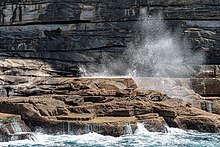
The ocean waters contain many chemical elements as dissolved ions. Elements dissolved in ocean waters have a wide range of concentrations. Some elements have very high concentrations of several grams per liter, such as sodium and chloride, together making up the majority of ocean salts. Other elements, such as iron, are present at tiny concentrations of just a few nanograms (10−9 grams) per liter.[116]
The concentration of any element depends on its rate of supply to the ocean and its rate of removal. Elements enter the ocean from rivers, the atmosphere and hydrothermal vents. Elements are removed from ocean water by sinking and becoming buried in sediments or evaporating to the atmosphere in the case of water and some gases. By estimating the residence time of an element, oceanographers examine the balance of input and removal. Residence time is the average time the element would spend dissolved in the ocean before it is removed. Heavily abundant elements in ocean water such as sodium, have high input rates. This reflects high abundance in rocks and rapid rock weathering, paired with very slow removal from the ocean due to sodium ions being comparatively unreactive and highly soluble. In contrast, other elements such as iron and aluminium are abundant in rocks but very insoluble, meaning that inputs to the ocean are low and removal is rapid. These cycles represent part of the major global cycle of elements that has gone on since the Earth first formed. The residence times of the very abundant elements in the ocean are estimated to be millions of years, while for highly reactive and insoluble elements, residence times are only hundreds of years.[116]
| Chemical element or ion | Residence time (years) |
|---|---|
| Chloride (Cl−) | 100,000,000 |
| Sodium (Na+) | 68,000,000 |
| Magnesium (Mg2+) | 13,000,000 |
| Potassium (K+) | 12,000,000 |
| Sulfate (SO42−) | 11,000,000 |
| Calcium (Ca2+) | 1,000,000 |
| Carbonate (CO32−) | 110,000 |
| Silicon (Si) | 20,000 |
| Water (H2O) | 4,100 |
| Manganese (Mn) | 1,300 |
| Aluminum (Al) | 600 |
| Iron (Fe) | 200 |
Nutrients
A few elements such as nitrogen, phosphorus, iron, and potassium essential for life, are major components of biological material, and are commonly known as "nutrients". Nitrate and phosphate have ocean residence times of 10,000[140] and 69,000[141] years, respectively, while potassium is a much more abundant ion in the ocean with a residence time of 12 million[142] years. The biological cycling of these elements means that this represents a continuous removal process from the ocean's water column as degrading organic material sinks to the ocean floor as sediment.
Phosphate from
Marine life
Life within the ocean evolved 3 billion years prior to life on land. Both the depth and the distance from shore strongly influence the biodiversity of the plants and animals present in each region.[148] The diversity of life in the ocean is immense, including:
- seabirds are a diverse group of birds that have adapted to a life mainly on the oceans. They feed on marine animals and spend most of their lifetime on water, many going on land only for breeding. Other birds that have adapted to oceans as their living space are penguins, seagulls and pelicans. Seven species of turtles, the sea turtles, also spend most of their time in the oceans.
- mangroves
- dinoflagellates, but also multicellular algae, such as some red algae (including organisms like Pyropia, which is the source of the edible nori seaweed), and brown algae (including organisms like kelp).
- prokaryotesfound throughout the world
- prokaryotes distinct from bacteria, that inhabit many environments of the ocean, as well as many extreme environments
- Fungi: many marine fungiwith diverse roles are found in oceanic environments
This article contains too many pictures for its overall length. |

Human uses of the oceans
The ocean has been linked to human activity throughout history. These activities serve a wide variety of purposes, including navigation and exploration, naval warfare, travel, shipping and trade, food production (e.g. fishing, whaling, seaweed farming, aquaculture), leisure (cruising, sailing, recreational boat fishing, scuba diving), power generation (see marine energy and offshore wind power), extractive industries (offshore drilling and deep sea mining), freshwater production via desalination.
Many of the world's goods are moved by
Oceans are also the major supply source for the
The ocean has a vast amount of
"Freedom of the seas" is a principle in international law dating from the seventeenth century. It stresses freedom to navigate the oceans and disapproves of war fought in international waters.[169] Today, this concept is enshrined in the United Nations Convention on the Law of the Sea (UNCLOS).[169]
The
Threats from human activities

Human activities affect marine life and marine habitats through many negative influences, such as marine pollution (including marine debris and microplastics) overfishing, ocean acidification and other effects of climate change on oceans.
Climate change
There are many
The various layers of the oceans have different temperatures. For example, the water is colder towards the bottom of the ocean. This temperature stratification will increase as the ocean surface warms due to rising air temperatures.[174]: 471 Connected to this is a decline in mixing of the ocean layers, so that warm water stabilises near the surface. A reduction of cold, deep water circulation follows. The reduced vertical mixing makes it harder for the ocean to absorb heat. So a larger share of future warming goes into the atmosphere and land. One result is an increase in the amount of energy available for tropical cyclones and other storms. Another result is a decrease in nutrients for fish in the upper ocean layers. These changes also reduce the ocean's capacity to store carbon.[175] At the same time, contrasts in salinity are increasing. Salty areas are becoming saltier and fresher areas less salty.[176]
Warmer water cannot contain the same amount of oxygen as cold water. As a result, oxygen from the oceans moves to the atmosphere. Increased thermal stratification may reduce the supply of oxygen from surface waters to deeper waters. This lowers the water's oxygen content even more.[177] The ocean has already lost oxygen throughout its water column. Oxygen minimum zones are increasing in size worldwide.[174]: 471
These changes harm marine ecosystems, and this can lead to biodiversity loss or changes in species distribution.[99] This in turn can affect fishing and coastal tourism. For example, rising water temperatures are harming tropical coral reefs. The direct effect is coral bleaching on these reefs, because they are sensitive to even minor temperature changes. So a small increase in water temperature could have a significant impact in these environments. Another example is loss of sea ice habitats due to warming. This will have severe impacts on polar bears and other animals that rely on it. The effects of climate change on oceans put additional pressures on ocean ecosystems which are already under pressure by other impacts from human activities.[99]Marine pollution
Plastic pollution
It is estimated that there is a stock of 86 million tons of plastic marine debris in the worldwide ocean as of the end of 2013, assuming that 1.4% of global plastics produced from 1950 to 2013 has entered the ocean and has accumulated there.
- Schmidt, Christian; Krauth, Tobias; Wagner, Stephan (October 11, 2017). "Export of Plastic Debris by Rivers into the Sea" (PDF). PMID 29019247.
The 10 top-ranked rivers transport 88–95% of the global load into the sea
- "Supporting Information: Export of plastic debris by rivers into the sea" (PDF).[full citation needed]</ref>[192] Asia was the leading source of mismanaged plastic waste, with China alone accounting for 2.4 million metric tons.[193]
Overfishing
Protection
Ocean protection serves to safeguard the ecosystems in the oceans upon which humans depend.[195][196] Protecting these ecosystems from threats is a major component of environmental protection. One of protective measures is the creation and enforcement of marine protected areas (MPAs). Marine protection may need to be considered within a national, regional and international context.[197] Other measures include supply chain transparency requirement policies, policies to prevent marine pollution, ecosystem-assistance (e.g. for coral reefs) and support for sustainable seafood (e.g. sustainable fishing practices and types of aquaculture). There is also the protection of marine resources and components whose extraction or disturbance would cause substantial harm, engagement of broader publics and impacted communities,[198] and the development of ocean clean-up projects (removal of marine plastic pollution). Examples of the latter include Clean Oceans International and The Ocean Cleanup.
In 2021, 43 expert scientists published the first scientific framework version that – via integration,
In March 2023 a High Seas Treaty was signed. It is legally binding. The main achievement is the new possibility to create marine protected areas in international waters. By doing so the agreement now makes it possible to protect 30% of the oceans by 2030 (part of the 30 by 30 target).[202][203] The treaty has articles regarding the principle "polluter-pays", and different impacts of human activities including areas beyond the national jurisdiction of the countries making those activities. The agreement was adopted by the 193 United Nations Member States.[204]
See also
- European Atlas of the Seas
- Land and water hemispheres
- List of seas
- Marine heatwave
- Ocean (disambiguation)
- Ocean world
- Planetary oceanography
- World Ocean Atlas
- World Oceans Day
References
- ^ a b Webb, Paul. "1.1 Overview of the Oceans". Roger Williams University Open Publishing – Driving learning and savings, simultaneously. Retrieved May 10, 2023.
- ^ "How deep is the ocean?". NOAA's National Ocean Service. Retrieved May 10, 2023.
- ^ "Challenger Deep – the Mariana Trench". Archived from the original on April 24, 2006. Retrieved July 30, 2012.
- ^ "Coastline – The World Factbook". Central Intelligence Agency.
- ^ "Coastal and Marine Ecosystems – Marine Jurisdictions: Coastline length". World Resources Institute. Archived from the original on April 19, 2012. Retrieved March 18, 2012.
- ^ a b "How does the temperature of ocean water vary? : Ocean Exploration Facts: NOAA Office of Ocean Exploration and Research". Home. March 5, 2013. Retrieved May 10, 2023.
- ^ a b "Voyager: How Long until Ocean Temperature Goes up a Few More Degrees?". Scripps Institution of Oceanography. March 18, 2014. Retrieved May 10, 2023.
- ^ a b c "8(o) Introduction to the Oceans". www.physicalgeography.net.
- ^ "Ocean." Merriam-Webster.com Dictionary, Merriam-Webster, https://www.merriam-webster.com/dictionary/ocean . Accessed March 14, 2021.
- ^ a b "ocean, n". Oxford English Dictionary. Retrieved February 5, 2012.
- ^ a b "ocean". Merriam-Webster. Retrieved February 6, 2012.
- ^ ISBN 978-1-139-16501-3.
- ^ "How much oxygen comes from the ocean?". National Ocean Service. National Oceanic and Atmospheric Administration U.S. Department of Commerce. February 26, 2021. Retrieved November 3, 2021.
- ^ a b Gordon, Arnold (2004). "Ocean Circulation". The Climate System. Columbia University. Retrieved July 6, 2013.
- ^ a b NOAA, NOAA. "What is a current?". Ocean Service Noaa. National Ocean Service. Retrieved December 13, 2020.
- ^ OCLC 781078031.
- ^ IUCN (2017) The Ocean and Climate Change , IUCN (International Union for Conservation of Nature) Issues Brief.
- ^ Drogin, Bob (August 2, 2009). "Mapping an ocean of species". Los Angeles Times. Retrieved August 18, 2009.
- ^ "Sea". Merriam-webster.com. Retrieved March 13, 2013.
- ISBN 978-9027264008; unlike Americans, speakers of British Englishdo not go swimming in "the ocean" but always "the sea".
- ^ "WordNet Search – sea". Princeton University. Retrieved February 21, 2012.
- ^ "What's the difference between an ocean and a sea?". Ocean facts. National Oceanic and Atmospheric Administration. Retrieved April 19, 2013.
- ^ ISBN 978-0-7864-5956-8. Retrieved August 26, 2022.
- ISBN 978-0754669197.
- ^ a b Ro, Christine (February 3, 2020). "Is It Ocean Or Oceans?". Forbes. Retrieved August 26, 2022.
- ^ "Ocean". Sciencedaily.com. Archived from the original on April 24, 2015. Retrieved November 8, 2012.
- ^ a b ""Distribution of land and water on the planet". UN Atlas of the Oceans. Archived from the original on March 3, 2016.
- JSTOR 210385.
- ^ Ὠκεανός, Henry George Liddell, Robert Scott, A Greek-English Lexicon, at Perseus project
- ^ Matasović, Ranko, A Reader in Comparative Indo-European Religion Zagreb: Univ of Zagreb, 2016. page 20.
- S2CID 247695232.
- ^ "Why do we have an ocean?". NOAA's National Ocean Service. June 1, 2013. Retrieved September 3, 2022.
- ^ "NASA Astrobiology". Astrobiology. June 5, 2017. Retrieved September 13, 2022.
- ^ ISBN 978-3642278334
- ISSN 0012-821X.
- S2CID 128825728.
- EurekAlert!. Retrieved August 28, 2020.
- EurekAlert!. Retrieved August 28, 2020.
- S2CID 221342529.
- ISBN 978-1-58381-109-2.
- ^ S2CID 241687784.
- ^ "The Water Cycle summary". USGS Water Science School. Archived from the original on January 16, 2018. Retrieved January 15, 2018.
- ^ Smith, Yvette (June 7, 2021). "Earth Is a Water World". NASA. Retrieved August 27, 2022.
- ^ "Water-Worlds". National Geographic Society. May 20, 2022. Retrieved August 24, 2022.
- ISSN 0094-5765.
- ^ "Ocean Worlds". Ocean Worlds. Archived from the original on August 27, 2022. Retrieved August 27, 2022.
- ^ "Where is Point Nemo?". NOAA. Retrieved February 20, 2015.
- ^ a b "Recommendation ITU-R RS.1624: Sharing between the Earth exploration-satellite (passive) and airborne altimeters in the aeronautical radionavigation service in the band 4 200–4 400 MHz (Question ITU-R 229/7)" (PDF). ITU Radiotelecommunication Sector (ITU-R). Retrieved April 5, 2015.
The oceans occupy about 3.35×108 km2 of area. There are 377412 km of oceanic coastlines in the world.
- ^ a b "Pacific Ocean". Encyclopedia of Earth. Retrieved March 7, 2015.
- ^ a b "Atlantic Ocean". Encyclopedia of Earth. Retrieved March 7, 2015.
- ^ a b "Indian Ocean". Encyclopedia of Earth. Retrieved March 7, 2015.
- ^ a b "Southern Ocean". Encyclopedia of Earth. Retrieved March 10, 2015.
- ^ a b "Limits of Oceans and Seas, 3rd edition" (PDF). International Hydrographic Organization. 1953. Archived from the original (PDF) on October 8, 2011. Retrieved December 28, 2020.
- ^ ISBN 978-81-7035-306-5. Archived from the originalon June 30, 2007. Retrieved April 10, 2006.
- ^ a b Ostenso, Ned Allen. "Arctic Ocean". Encyclopædia Britannica. Retrieved July 2, 2012.
As an approximation, the Arctic Ocean may be regarded as an estuary of the Atlantic Ocean.
- ^ a b "Arctic Ocean". Encyclopedia of Earth. Retrieved March 7, 2015.
- ^ Pidwirny, Michael (March 28, 2013). "Plate tectonics". The Encyclopedia of Earth. Archived from the original on October 21, 2014. Retrieved September 20, 2013.
- ^ "Plate Tectonics: The Mechanism". University of California Museum of Paleontology. Archived from the original on July 30, 2014. Retrieved September 20, 2013.
- ^ "What is the longest mountain range on earth?". National Ocean Service. US Department of Commerce. Retrieved October 17, 2014.
- ^ a b c "NOAA – National Oceanic and Atmospheric Administration – Ocean". Noaa.gov. Retrieved February 16, 2020.
- ^ ISBN 978-0-340-04944-0.
- ISBN 978-0-14-051094-2.
- ^ "Thames Barrier engineer says second defence needed". BBC News. January 5, 2013. Archived from the original on September 26, 2013. Retrieved September 18, 2013.
- ^ Fleming, Nic (May 27, 2015). "Is the sea really blue?". BBC - Earth. BBC. Retrieved August 25, 2021.
- ^ Webb, Paul (July 2020), "6.5 Light", Introduction to Oceanography, retrieved July 21, 2021
- .
- PMID 17256912.
- ^ a b "The Water Cycle: The Oceans". US Geological Survey. Retrieved July 17, 2021.
- S2CID 206691291.
- ISBN 978-0-19-860687-1.
- ^ a b c d "Volumes of the World's Oceans from ETOPO1". NOAA. Archived from the original on March 11, 2015. Retrieved March 7, 2015.
{{cite web}}: CS1 maint: bot: original URL status unknown (link) - ISBN 978-0-08-043317-2.
- ^ ISBN 0321814053.
- Devon)
- .
- ^ Laird, Anne (2006). "Observed Statistics of Extreme Waves". Naval Postgraduate School (Monterey).
- ^ "Ocean waves". Ocean Explorer. National Oceanic and Atmospheric Administration. Retrieved April 17, 2013.
- ^ "Life of a Tsunami". Tsunamis & Earthquakes. US Geological Survey. Retrieved July 14, 2021.
- ^ "Physics of Tsunamis". National Tsunami Warning Center of the USA. Retrieved July 14, 2021.
- ^ "Tides". Ocean Explorer. National Oceanic and Atmospheric Administration. Retrieved April 20, 2013.
- ^ a b "Tides and Water Levels". NOAA Oceans and Coasts. NOAA Ocean Service Education. Retrieved April 20, 2013.
- ^ "Tidal amplitudes". University of Guelph. Retrieved September 12, 2013.
- )
- ^ "Weird Science: Extreme Tidal Ranges". Exploring Our Fluid Earth: Teaching Science as Inquiry. University of Hawaiʻi. Retrieved November 9, 2021.
- ^ "Where are the Highest Tides in the World?". Casual Navigation. Retrieved November 9, 2021.
- ^ Drazen, Jeffrey C. "Deep-Sea Fishes". School of Ocean and Earth Science and Technology, the University of Hawaiʻi at Mānoa. Archived from the original on May 24, 2012. Retrieved June 7, 2007.
- ^ "Scientists map Mariana Trench, deepest known section of ocean in the world". The Telegraph. Telegraph Media Group. December 7, 2011. Archived from the original on December 8, 2011. Retrieved March 23, 2012.
- ^ )
- ^ "What is a thermocline?". National Ocean Service. US Department of Commerce. Retrieved February 7, 2021.
- ^ Qadri, Syed (2003). "Volume of Earth's Oceans". The Physics Factbook. Retrieved June 7, 2007.
- hdl:1912/3862.
- ^ Where is Earth's water?, United States Geological Survey.
- , 2010.
- ^ Water in Crisis: Chapter 2, Peter H. Gleick, Oxford University Press, 1993.
- ^ World Water Resources: A New Appraisal and Assessment for the 21st Century (Report). UNESCO. 1998. Archived from the original on September 27, 2013. Retrieved June 13, 2013.
- ISBN 0-8493-2391-6.
- ^ OCLC 781078031.
- ^ ISBN 978-1-00-915796-4. Archived(PDF) from the original on March 29, 2023. Retrieved March 26, 2023.
- ^ PMID 36643611. Text was copied from this source, which is available under a Creative Commons Attribution 4.0 International License
- ^ Fox-Kemper, B., H.T. Hewitt, C. Xiao, G. Aðalgeirsdóttir, S.S. Drijfhout, T.L. Edwards, N.R. Golledge, M. Hemer, R.E. Kopp, G. Krinner, A. Mix, D. Notz, S. Nowicki, I.S. Nurhati, L. Ruiz, J.-B. Sallée, A.B.A. Slangen, and Y. Yu, 2021: Chapter 9: Ocean, Cryosphere and Sea Level Change Archived 2022-10-24 at the Wayback Machine. In Climate Change 2021: The Physical Science Basis. Contribution of Working Group I to the Sixth Assessment Report of the Intergovernmental Panel on Climate Change Archived 2021-08-09 at the Wayback Machine [Masson-Delmotte, V., P. Zhai, A. Pirani, S.L. Connors, C. Péan, S. Berger, N. Caud, Y. Chen, L. Goldfarb, M.I. Gomis, M. Huang, K. Leitzell, E. Lonnoy, J.B.R. Matthews, T.K. Maycock, T. Waterfield, O. Yelekçi, R. Yu, and B. Zhou (eds.)]. Cambridge University Press, Cambridge, United Kingdom and New York, NY, USA, pp. 1211–1362
- ^ "IPCC Fourth Assessment Report: Climate Change 2007, Working Group I: The Physical Science Basis, 5.6 Synthesis". IPCC (archive). Retrieved July 19, 2021.
- ^ "Evaporation minus precipitation, Latitude-Longitude, Annual mean". ERA-40 Atlas. ECMWF. Archived from the original on February 2, 2014.
- ISBN 978-0203440513.
- PMID 21141660. Archived from the original(PDF) on May 14, 2014.
- OCLC 664005236.
- ^ Jeffries, Martin O. (2012). "Sea ice". Encyclopedia Britannica. Britannica Online Encyclopedia. Retrieved April 21, 2013.
- ^ Wadhams, Peter (January 1, 2003). "How Does Arctic Sea Ice Form and Decay?". Arctic theme page. NOAA. Archived from the original on March 6, 2005. Retrieved April 25, 2005.
- ISBN 978-1-60223-101-6.
- ISBN 978-1119027898.
- ^ "Sea Ice". National Snow and Ice Data Center. Retrieved November 22, 2022.
- ^ "Tidal Currents – Currents: NOAA's National Ocean Service Education". National Ocean Service. US Department of Commerce. Retrieved February 7, 2021.
- ^ )
- ^ .
- ^ Baranova, Olga. "World Ocean Atlas 2009". National Centers for Environmental Information (NCEI). Retrieved January 18, 2022.
- ^ OCLC 781078031.
- ^ "Can the ocean freeze? Ocean water freezes at a lower temperature than freshwater". NOAA. Archived from the original on July 6, 2020. Retrieved January 2, 2019.
- ^ "Hydrologic features and climate". Encyclopedia Britannica. Retrieved January 18, 2022.
- ^ "Salinity and Brine". National Snow and Ice Data Center. Retrieved January 18, 2022.
- ^
- ^ Garcia, H.E.; Locarnini, R.A.; Boyer, T.P.; Antonov, J.I. (2006). Levitus, S. (ed.). World Ocean Atlas 2005, Volume 3: Dissolved Oxygen, Apparent Oxygen Utilization, and Oxygen Saturation. Washington, D.C: NOAA Atlas NESDIS 63, U.S. Government Printing Office. p. 342.
- ^ ISBN 978-0750637152.
- ^ "Dissolved Gases other than Carbon Dioxide in Seawater" (PDF). soest.hawaii.edu. Retrieved May 5, 2014.
- ^ "Dissolved Oxygen and Carbon Dioxide" (PDF). chem.uiuc.edu. Archived from the original (PDF) on June 12, 2014. Retrieved February 3, 2014.
- ^ "12.742. Marine Chemistry. Lecture 8. Dissolved Gases and Air-sea exchange" (PDF). Retrieved May 5, 2014.
- ^ "Ocean carbon cycle". GRID-Arendal. June 5, 2009. Retrieved January 18, 2022.
- PMID 29301986.
- .
- S2CID 255431338.
Figure 1f
- ^ Arias, P.A., N. Bellouin, E. Coppola, R.G. Jones, G. Krinner, J. Marotzke, V. Naik, M.D. Palmer, G.-K. Plattner, J. Rogelj, M. Rojas, J. Sillmann, T. Storelvmo, P.W. Thorne, B. Trewin, K. Achuta Rao, B. Adhikary, R.P. Allan, K. Armour, G. Bala, R. Barimalala, S. Berger, J.G. Canadell, C. Cassou, A. Cherchi, W. Collins, W.D. Collins, S.L. Connors, S. Corti, F. Cruz, F.J. Dentener, C. Dereczynski, A. Di Luca, A. Diongue Niang, F.J. Doblas-Reyes, A. Dosio, H. Douville, F. Engelbrecht, V. Eyring, E. Fischer, P. Forster, B. Fox-Kemper, J.S. Fuglestvedt, J.C. Fyfe, et al., 2021: Technical Summary Archived 21 July 2022 at the Wayback Machine. In Climate Change 2021: The Physical Science Basis. Contribution of Working Group I to the Sixth Assessment Report of the Intergovernmental Panel on Climate Change Archived 9 August 2021 at the Wayback Machine [Masson-Delmotte, V., P. Zhai, A. Pirani, S.L. Connors, C. Péan, S. Berger, N. Caud, Y. Chen, L. Goldfarb, M.I. Gomis, M. Huang, K. Leitzell, E. Lonnoy, J.B.R. Matthews, T.K. Maycock, T. Waterfield, O. Yelekçi, R. Yu, and B. Zhou (eds.)]. Cambridge University Press, Cambridge, United Kingdom and New York, NY, USA (value taken from Figure TS.11 (d) on page 75)
- ^ "Ocean Acidification". National Geographic. April 27, 2017. Archived from the original on October 9, 2018. Retrieved October 9, 2018.
- S2CID 255431338.
- ^ S2CID 225741986.
 Text was copied from this source, which is available under a Creative Commons Attribution 4.0 International License
Text was copied from this source, which is available under a Creative Commons Attribution 4.0 International License - ^ ISBN 978-0-521-83313-4.
- ISBN 0-444-50946-1
- ISBN 0471048313.
- ^ IPCC, 2021: Annex VII: Glossary Archived 5 June 2022 at the Wayback Machine [Matthews, J.B.R., V. Möller, R. van Diemen, J.S. Fuglestvedt, V. Masson-Delmotte, C. Méndez, S. Semenov, A. Reisinger (eds.)]. In Climate Change 2021: The Physical Science Basis. Contribution of Working Group I to the Sixth Assessment Report of the Intergovernmental Panel on Climate Change Archived 9 August 2021 at the Wayback Machine [Masson-Delmotte, V., P. Zhai, A. Pirani, S.L. Connors, C. Péan, S. Berger, N. Caud, Y. Chen, L. Goldfarb, M.I. Gomis, M. Huang, K. Leitzell, E. Lonnoy, J.B.R. Matthews, T.K. Maycock, T. Waterfield, O. Yelekçi, R. Yu, and B. Zhou (eds.)]. Cambridge University Press, Cambridge, United Kingdom and New York, NY, USA
- ^ "Calculation of residence times in seawater of some important solutes" (PDF). gly.uga.edu. Archived from the original (PDF) on November 23, 2018. Retrieved February 3, 2014.
- OCLC 781078031.
- ^ "Monterey Bay Aquarium Research Institute".
- ^ "Monterey Bay Aquarium Research Institute".
- ^ "Potassium". www3.mbari.org.
- S2CID 1872341.
- S2CID 1450932.
- S2CID 858311.
- S2CID 206562728.
- doi:10.3389/fmars.2017.00222..
 Material was copied from this source, which is available under a Creative Commons Attribution 4.0 International License
Material was copied from this source, which is available under a Creative Commons Attribution 4.0 International License - ^ "Chapter 34: The Biosphere: An Introduction to Earth's Diverse Environment". Biology: Concepts & Connections. section 34.7. Archived from the original on July 13, 2018. Retrieved May 14, 2014.
- ^ PMID 31213707..
 Modified text was copied from this source, which is available under a Creative Commons Attribution 4.0 International License
Modified text was copied from this source, which is available under a Creative Commons Attribution 4.0 International License - ISBN 978-0-691-13720-9.
- OCLC 213451450.
- PMID 29784790.
- ^ "Census Of Marine Life". Smithsonian. April 30, 2018. Retrieved October 29, 2020.
- ^ Abercrombie, M., Hickman, C.J. and Johnson, M.L. 1966.A Dictionary of Biology. Penguin Reference Books, London
- ^ "Oceanic Institute". www.oceanicinstitute.org. Archived from the original on January 3, 2019. Retrieved December 1, 2018.
- ^ "Ocean Habitats and Information". January 5, 2017. Archived from the original on April 1, 2017. Retrieved December 1, 2018.
- ^ "Facts and figures on marine biodiversity | United Nations Educational, Scientific and Cultural Organization". www.unesco.org. Retrieved December 1, 2018.
- ^ United States Environmental Protection Agency (March 2, 2006). "Marine Ecosystems". Retrieved August 25, 2006.
- ISBN 978-1136212475.
- S2CID 26206024.
- ISBN 978-0-87033-550-1.
- ^ "Industry Globalization | World Shipping Council". www.worldshipping.org. Archived from the original on January 27, 2021. Retrieved May 4, 2021.
- ^ S2CID 242949831.
- ^ "Fisheries: Latest data". GreenFacts. Retrieved April 23, 2013.
- ^ a b "What is Ocean Energy". Ocean Energy Systems. 2014. Retrieved May 14, 2021.
- ISBN 978-3-540-74894-6.
- ^ "Offshore Wind Power 2010". BTM Consult. 22 November 2010. Archived from the original on 30 June 2011. Retrieved 25 April 2013.
- ^ Lamb, Robert (2011). "How offshore drilling works". HowStuffWorks. Retrieved May 6, 2013.
- ^ a b "The United Nations Convention on the Law of the Sea (A historical perspective)". United Nations Division for Ocean Affairs and the Law of the Sea. Retrieved May 8, 2013.
- OCLC 798531922.
- PMID 31406130.
- S2CID 57825894.
- ^ doi:10.1146/annurev-environ-012320-083019.
 Text was copied from this source, which is available under a Creative Commons Attribution 4.0 International License Archived 2017-10-16 at the Wayback Machine
Text was copied from this source, which is available under a Creative Commons Attribution 4.0 International License Archived 2017-10-16 at the Wayback Machine - ^ a b Bindoff, N.L., W.W.L. Cheung, J.G. Kairo, J. Arístegui, V.A. Guinder, R. Hallberg, N. Hilmi, N. Jiao, M.S. Karim, L. Levin, S. O'Donoghue, S.R. Purca Cuicapusa, B. Rinkevich, T. Suga, A. Tagliabue, and P. Williamson, 2019: Chapter 5: Changing Ocean, Marine Ecosystems, and Dependent Communities Archived 2019-12-20 at the Wayback Machine. In: IPCC Special Report on the Ocean and Cryosphere in a Changing Climate Archived 2021-07-12 at the Wayback Machine [H.-O. Pörtner, D.C. Roberts, V. Masson-Delmotte, P. Zhai, M. Tignor, E. Poloczanska, K. Mintenbeck, A. Alegría, M. Nicolai, A. Okem, J. Petzold, B. Rama, N.M. Weyer (eds.)]. In press.
- ^ Freedman, Andrew (September 29, 2020). "Mixing of the planet's ocean waters is slowing down, speeding up global warming, study finds". The Washington Post. Archived from the original on October 15, 2020. Retrieved October 12, 2020.
- .
- from the original on February 18, 2022. Retrieved October 20, 2022.
- OCLC 1052566532.
- ^ "Marine Pollution". Education | National Geographic Society. Retrieved June 19, 2023.
- ^ Duce, Robert; Galloway, J.; Liss, P. (2009). "The Impacts of Atmospheric Deposition to the Ocean on Marine Ecosystems and Climate WMO Bulletin Vol 58 (1)". Archived from the original on December 18, 2023. Retrieved September 22, 2020.
- ^ "What is the biggest source of pollution in the ocean?". National Ocean Service (US). Silver Spring, MD: National Oceanic and Atmospheric Administration. Retrieved September 21, 2022.
- ISBN 978-0312347291.
- ^ "Marine plastic pollution". IUCN. November 2021. Retrieved May 27, 2023.
- ^ "Nanoplastics in snow: The extensive impact of plastic pollution". Open Access Government. January 26, 2022. Retrieved February 1, 2022.
- .
- ^ "The average person eats thousands of plastic particles every year, study finds". Environment. June 5, 2019. Archived from the original on February 17, 2021. Retrieved March 17, 2023.
- ^ a b Microplastics and Micropollutants in Water: Contaminants of Emerging Concern (Report). European Investment Bank. February 27, 2023.
- S2CID 246672629.
- S2CID 252251921.
- ^ "Drowning in Plastics – Marine Litter and Plastic Waste Vital Graphics". UNEP – UN Environment Programme. October 21, 2021. Retrieved March 21, 2022.
- ^ Wright, Pam (June 6, 2017). "UN Ocean Conference: Plastics Dumped In Oceans Could Outweigh Fish by 2050, Secretary-General Says". The Weather Channel. Retrieved May 5, 2018.
- ^ Harald Franzen (November 30, 2017). "Almost all plastic in the ocean comes from just 10 rivers". Deutsche Welle. Retrieved December 18, 2018.
It turns out that about 90 percent of all the plastic that reaches the world's oceans gets flushed through just 10 rivers: The Yangtze, the Indus, Yellow River, Hai River, the Nile, the Ganges, Pearl River, Amur River, the Niger, and the Mekong (in that order).
- ^ Hotz, Robert Lee (February 13, 2015). "Asia Leads World in Dumping Plastic in Seas". The Wall Street Journal. Archived from the original on February 23, 2015.
- ^ Scales, Helen (March 29, 2007). "Shark Declines Threaten Shellfish Stocks, Study Says". National Geographic News. Archived from the original on November 6, 2007. Retrieved May 1, 2012.
- ^ "Protecting the Marine Environment". www.epa.gov. March 26, 2014. Retrieved October 25, 2021.
- ^ "Quantitative targets for marine protection: a review of the scientific basis and applications" (PDF). Retrieved October 25, 2021.
- ^ Farran, Sue. "Is marine protection compatible with the right to economic development in Pacific Island States?".
- S2CID 230555294.
- PMID 31016243.
- ^ "Improving ocean protection with the first marine protected areas guide". Institut de Recherche pour le Développement. Retrieved October 19, 2021.
- S2CID 237473020.
- ^ Kim, Juliana; Treisman, Rachel. "What to know about the new U.N. high seas treaty – and the next steps for the accord". NPR. Retrieved March 9, 2023.
- ^ Flores, Gaby. "How people power helped protect the oceans". Greenpeace. Retrieved March 9, 2023.
- ^ Hemingway Jaynes, Cristen (June 20, 2023). "Newly Adopted UN High Seas Treaty Gives Ocean a 'Fighting Chance'". Ecowatch. Retrieved June 23, 2023.
Further reading
- Peters, Kimberley, et al. eds. The Routledge Handbook of Ocean Space (2022), how experts in 32 fields study and interpret the oceans, onlne book review

